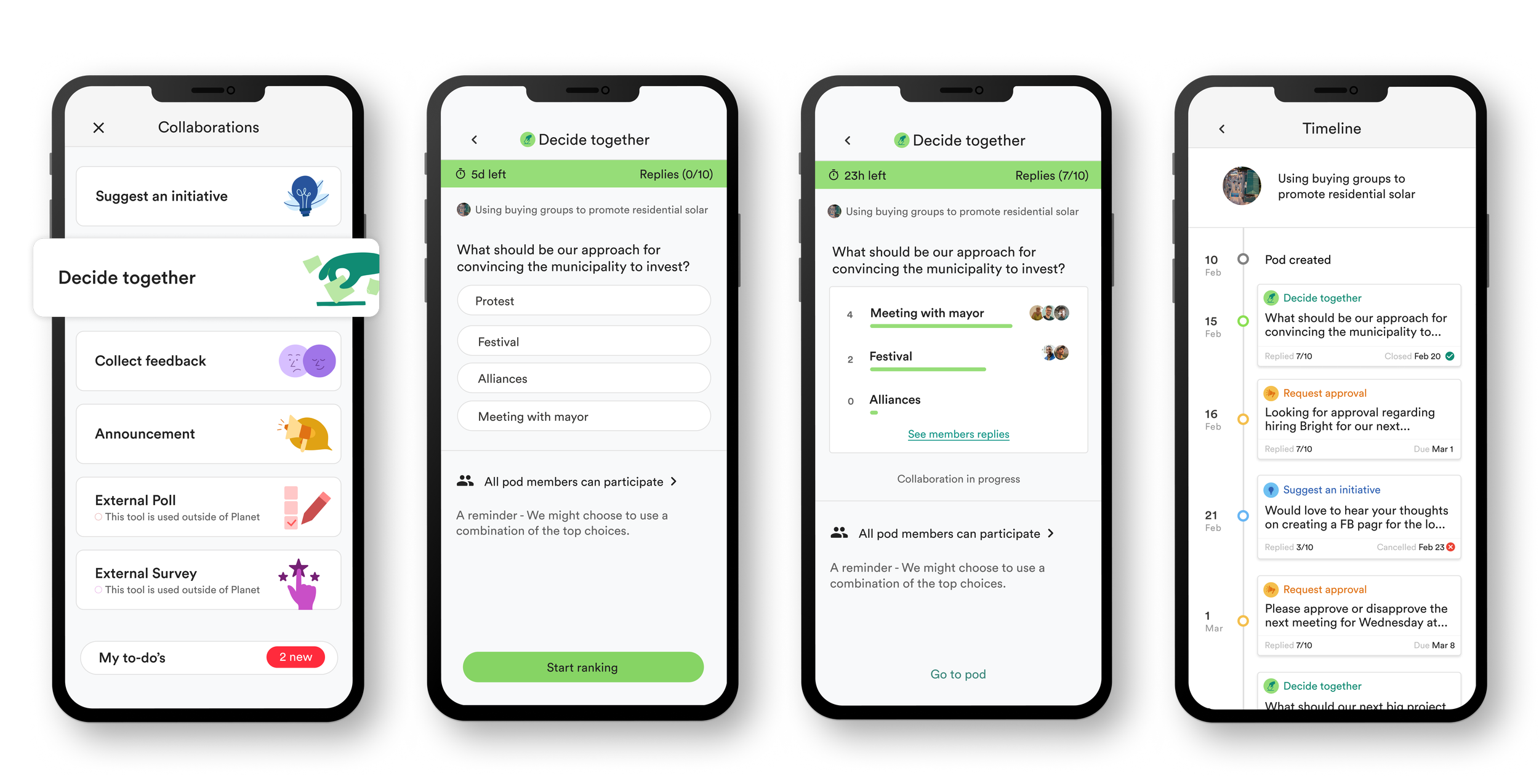Planet — A single hub to amplify climate action goals
OVERVIEW
We began working with the founders of Planet (Climate Action Systems at the time) in the early stages of their work. They were on a mission to create a dynamic, collaborative project management platform to help connect climate activists and experts around the world.
ROLE
UX Design & Research
Brand Implementation
Project Manager
TEAM
Verticalloop

The problem
Upon approaching our team, Planet identified a critical challenge that demanded a strategic resolution. The biggest concern was deciphering the distinct positioning of their platform in an online world saturated with climate-related apps and social networks. With an ambitious vision, Planet sought to push conventional boundaries by merge a project management platform with the dynamics of a social network.
Market saturation was a big challenge as the climate-related app sector was already overflowing — making it top priority for Planet to carve out a niche for itself. Understanding how to distinguish their unique tools amidst a plethora of alternatives was of utmost importance.
Creating a platform that not only served project management needs but also fostered a vibrant social community posed a challenge to user engagement.
My role
I wore many hats for the Planet app as I was the main designer responsible for the product design and UX/UI experience for the app. Some of my key achievements were:
Conducting in-depth user research. As Planet pivoted target audiences a few different times, I devled deep into understanding the dynamics of each audience by empathizing with their needs, preferences, pain points and biggest struggles.
Navigating a versatile role: I effectively switched between roles as a UX researcher, UX designer, and UX writer, contributing to a holistic user experience, tone and voice.
Creating a design system: As the project grew, I spearheaded the creation of a comprehensive design system for the Planet App, ensuring consistency and efficiency in the user interface.
Effective Collaboration: I worked seamlessly with the Founder, Project Manager, the marketing team, and the development team, fostering cohesive communication and alignment of goals.

Understanding the target audience
I used a systematic problem-solving strategy to deeply understand our audiences pain points and goals. Due to its complexity, the Planet app was targeting 3 main user personas at different levels on climate-action involvement. All 3 personas fell between the ages of 18-60 and were avid smart phone users.
First, let’s meet Fiona — the alarmed newbie who has little to no direction in the world of climate activism.
Next, let’s meet Ilan — the knowledgeable sideliner who wants to get more involved but doesn’t really know how.
Lastly, let’s meet Adam — the enthusiastic climate expert on a life’s mission to make drastic change.
Designing
When it came to designing and mapping out the UX for the app, we stuck to motto KISS — keep it super simple.
From the start of the project, I conducted in-depth research to uncover how we can add value to the users in order to spark the desire for them to keep coming back to the app. In this process, it led me to understand that Planet needed to offer a learning/educational element to the app to speak to the “newer and more curious” climate activists.
That’s were the concept of "topics of impact” was born. Users can browse an extensive database of climate related topics and follow them to get more relevant and related content on their feeds. These topics can be tagged on users profiles, reach-outs and pods so when others browse, they can find valuable information. As users learn, so does Planet.
Pods are where the action happens. Users can create or join a group of motivated, like-minded individuals who are learning about how to make a difference by chatting, polling and ranking initiatives.
Pods can be found via the search or as the app gets to know you, it will start suggesting Pods based on your interests. In order to make Pods easy to find and connect to, they are required to have specific titles stating the climate initiative, location (if applicable), and be tagged using the relevant topics of impact.
Within the Pod, members may utilize collaboration tools in order to have an organized and collaborative approach to tackling their projects. They can suggest new initiatives, poll the group for their input, collect feedback on ideas, and best of all - track their progress. The tools were created specifically to assist climate initiatives in streamlining workflows and staying on top of timelines.

Results & takeaways
Being part of the Planet App for nearly two years was an incredible learning experience for me as I not only grew as a UX designer but I learned more about climate initiatives that I was able to implement in my own life. Being involved in a project that helps promote climate action around the world was truly inspiring. Watching the app go from conception to launch was so cool!
Some of my key takeaways from this project are:
Get super specific on a target audience. With a solid target audience in mind, it is much easier to understand the users wants, needs, pains and frustrations. It’s important to use them as a guide rather than our own intuitions.
Be adaptable, open-minded and flexible. Be open to pivoting completely — as you go, you learn and adapt.
Design systems are extremely important. They help keep consistency and scalability and they streamline the entire design and development process for everyone involved.










